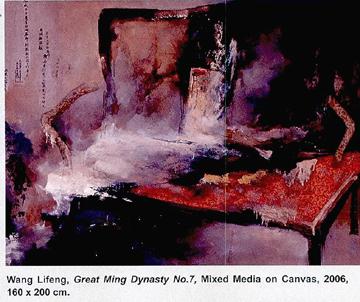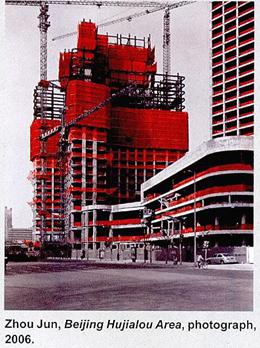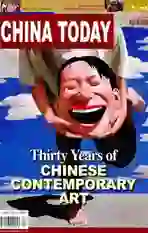Modern Art in an Ancient Setting
2008-04-05staffreporterDANEDWARDS
staff reporter DAN EDWARDS

ASCENDING the ancient stone steps to Red Gate Gallery reveals the quintessential Beijing panorama. The gallery is housed in Dongbianmen Watchtower, a Ming Dynasty structure straddling the last crumbling vestiges of Beijings city wall. Like a besieged bastion of the citys imperial past, the watchtower is hemmed in by railway lines and Beijings Second Ring Road. The glass and steel edifices of the CBD loom in the distance. Its appropriate that this ancient fortress, surrounded by a cornucopia of modern development, houses a gallery that has long been a cultural bastion of a more contemporary kind.
For 17 years, Red Gate has been exhibiting Chinese contemporary art. The story of Red Gate, and its Australian director Brian Wallace, is the story of the rise of Chinas contemporary art movement – from a barely tolerated, underground practice to a highly visible, internationally renowned creative industry.
Early Days
When Brian moved to Beijing in the mid-1980s, he found a nascent art scene completely without institutional support, but hungry for a chance to express itself. He writes evocatively of that time in To the Watchtower, a book produced to celebrate Red Gates 15th anniversary in 2006: “Young artists circulated through Beijing with slides of their work, or the work itself tucked under their arms, hoping to connect with people interested in their art. They would exhibit on foreigners sofas or guide the curious to their tiny homes.”
The young Australian befriended many of these artists and quickly fell into the organizational role he was to play for the next two decades. “There was no official support, and no galleries as such,” he recalls. “Many of these exhibitions were just organized by the artists themselves. So with my artist friends we thought, ‘why dont we take it to a higher level, and send out proper invitations and have cocktail parties for the openings? So thats what I started doing.”

In 1990, Brian enrolled in a one-year art history course at Beijings famous Central Academy of Fine Arts. The experience helped him understand what he had been seeing. “It put everything in perspective by giving me an overview of Chinese art history – ‘Going back 5,000 years was the official line. It gave me a very good introduction to Chinese art history in quite a short period.”
As the course drew to a close Brian faced a choice. With no job and rapidly dwindling finances, he needed to either return to the business world he had come from, or do something new. Drawing on his experiences at the Academy, as well as his personal friends and contacts, he began mulling over the possibility of opening an art gallery.
Enter Red Gate
Red Gates doors opened in July 1991 with an exhibition of works from five Chinese artists. The number of galleries in Beijing at that time could be counted on one hand – with fingers to spare. Nonetheless, Brian made his first sale the day of Red Gates opening. But running a gallery in the 1990s was hardly a monetary bonanza. As recently as 2001, Brian couldnt afford to print a catalogue for Red Gates 10th anniversary exhibition – hard to believe now that Chinese art is fetching astronomical prices on international markets.
The burgeoning international interest in Chinese contemporary art has developed in conjunction with an explosion of galleries in Beijing, Shanghai and other Chinese cities. Recent years have also seen the rise of “art zones,” clusters of galleries and studios complete with bookshops, cafés and increasingly upmarket restaurants. Red Gate opened a second branch in the most famous of these, Beijings “798,” in December 2005.
“Up until four years ago, there were only three galleries really doing something in Beijing, and one in Shanghai,” reflects Brian. “But then the larger market arrived, and coincided with 798 and Morgan Shan Lu [Shanghais largest art zone]. Then the tremendous interest from overseas, which had been growing steadily for a long time – and some domestic interest as well – all kicked in together. There was a lot of money being passed around, and a lot of artists played to that, and either put their prices up or just turned more commercial. Including some of the most senior artists in the contemporary art scene.”
Despite rampant commercialization, Brian is encouraged by the growing infrastructure of art fairs, biennales and auction houses that has accompanied the influx of capital. He is also heartened by the fact that the creation of art zones like 798 has largely been driven by the artists themselves. All these developments, he believes, are “absolutely necessary to mature the industry, and make artists more aware of their own practice.”
During the whirlwind of the past few years, Brian has remained dedicated to his original raison-dêtre. His close, personal relationships with the artists in Red Gates stable has informed the gallerys philosophy and operation since its inception. “Were different from some of the other galleries, who do exhibition after exhibition of new artists. They very quickly run up a huge number of artists in their stable, but how much work they can do for each one beyond their first exhibition, who knows?”
Residencies
Brians long-term commitment to fostering Chinese art is also reflected in Red Gates residency program, which has brought more than 150 foreign artists and scholars to China. Even more importantly, since the middle of this decade Red Gate has been instrumental in bringing over a dozen provincial Chinese artists to Beijing. Provided with a work space and a small stipend, many have seen their careers blossom while in the capital.
“Most of them have ended up staying and setting up their own studios,” says Brian. “And their relationship with the market has started to take off. I think one of the best examples is Chen Wenling from Xiamen. He was already fairly well known, but since landing in Beijing has become a very successful artist, both commercially and through exhibitions and curatorial programs.”
From humble beginnings exhibiting on expatriates couches, to record sales in the leading auction houses of the world, Chinese contemporary art has developed a seemingly unstoppable momentum. But years before the international spotlight fell on Beijing and fortunes were made in the art world, a young Australian armed with little more than a vision and a handful of creative friends set out to give Chinese contemporary art a home. Red Gates triumphant survival is a testament not only to the quality of Chinese work, but also Brians commitment to his original dream.
